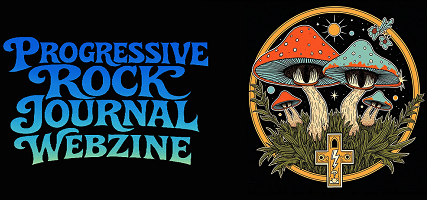Since its genesis as Tobias Graef’s solo project in 2016, Mihrax has grown into a full-fledged Neo Prog outfit. With their sophomore album “ROX” (released March 07, 2025), the band shifts from sprawling instrumental epics to tighter, hook-driven compositions that blend Progressive Rock, Metal, and Pop sensibilities.
What inspired you in 2016 to channel your ideas into a solo instrumental album rather than join an existing band?
Tobias: “I guess you could call it frustration rather than inspiration. At the time, Tobias Graef (Mihrax’s keyboardist) didn’t know any musicians or friends who listened to or played progressive rock. So there were two options available at the time: Hope for a miracle and wait to meet the right people at some point or just go for it and realize his ideas. This inevitably brought him to the point of being able to transfer his own ideas into a solo album and develop his musical and artistic approaches completely freely. The idea of recording an instrumental progressive rock album, framed as a concept in the form of an audio book, turned out to be an exciting and constructive working process, of which nobody would have thought or even expected that those compositions would soon form the musical basis of the band Mihrax. Although the aforementioned solo album with the title “Mirax” (without h) falls far behind our current releases in terms of quality, it symbolizes the basic idea of progression: successive development, paired with a little courage, patience and a lot of passion.“
After your expansive 2019 debut, what prompted the leaner, more concise songwriting on “ROX”?
Boris: “In the year 2019, shortly after the release of the debut album “Mihrax”, Frank Ziebner (Mihrax’s former
drummer, vocalist and sound engineer) left the band in order to pursue new musical challenges. Then,
early 2020, COVID hit the world and basically shut down cultural life. Everybody had to stay home
and no live performances were possible. During these difficult times, the band line up re-formed itself.
Andreas Wittwer (drums), Thorsten Schlüter (lead guitar) and Boris Elfert (vocals and rhythm guitar)
joined Tobias Graef (keyboards) and Thomas Graef (bass) to form the band MIHRAX as it exists today.
All band members already loved progressive rock and it was clear from the beginning that we wanted
to make prog but all band members also had different musical backgrounds (punk, blues rock, 80s
melodic rock, Top 40 cover, Classic Rock cover…) and each one had some ideas in his backpack to
bring to the table. Some of the song ideas actually originated from COVID times when being at home
and writing songs was more or less the only thing one could do. When the actual song writing process
for ROX started, it felt sometimes like someone threw a lot of lego bricks into a room (the lego bricks
representing various songs, sound ideas, riffs and sound patterns) and the band assembled these bricks
into colorful new buildings and structures. We purposely decided that we will not exclude any idea
right from the beginning. Some ideas did not make it but those who made it all the way to ROX are
now the foundation of our new crossover prog style.“
Which three artists or albums most directly shaped the sound and style of “ROX”?
Boris: “In our case, it is very hard to find just three influential artists or albums but some examples are Porcupine Tree as well as Steven Wilson’s solo work with all its explorations into the world of progressive rock, metal and even pop. It is impossible to list just one influential album of his work. Other influences are bands like The Pineapple Thief, Marillion, IQ and Dream Theater.“
When composing, do you prioritize strong vocal melodies or memorable instrumental motifs first?
Boris: “Most of our songs started with instrumental motifs for which we later developed vocal melodies and lyrics. Those instrumental motifs could be keyboard patterns, guitar riffs or bass lines. We would then blend in other instruments like drums or lead guitars before finishing it with vocal melodies and hook lines for the choruses.“
What key element—lyrical theme, riff, or production trick—do you consider essential to this single’s impact?
Boris: “There was no single key element. Or maybe the key element was actually the collective work resulting in our crossover progressive sound.“
Can you describe a spontaneous studio contribution from a bandmate that made it onto the final record?
Boris: “The most interesting story is probably that of the song “Stuck In A Maze”. The first version of this song was a composition of Boris Elfert of almost 4 minutes length, using acoustic guitar in a minimal instrumental mix, maybe a bit Pink Floyd-ish in style. Tobias Graef took the original tracks in order to re-arrange them and transformed them into the massive 10min prog rock-song one can hear on ROX today. While the vocal melody and the basic chord progression are still very much like the original version, the song now features different time signatures as well as rock, metal and even jazzy parts. Tobias’ transformational work is probably a good example of the creative freedom that the band encouraged for the song writing of ROX.“
Which techniques did you use to maintain both clarity and complexity in the mix?
Andreas: “The whole thing is a process, there are no shortcuts here. Each individual song stands on its own and therefore deserves full attention and its own mix. You have to be careful that the mix follows the song and not the other way around. The mix must work out the dynamic and musical twists and turns and create clarity here. This is more important than purely technical clarity and audibility in the mix. Clarity in the mix means that the individual musical voices, instruments and tracks must be tidied up. What is felt at the moment of listening must be placed in the foreground, which represents the message of the song at the time of listening. Everything else is of secondary importance and can be relegated to the second or third row. A graduation in depth does not mean that something is lost or put on the back burner, everything remains part of the overall message. The same applies to staggering in width. It helps to have a very specific idea of where individual instruments should be placed in the stereo base and how a song should ultimately sound. In addition to overcoming purely technical challenges, such as recognizing clashing frequency ranges and resolving overlapping voices and instruments, the aim is always to capture the message of the song and present it to the listener. A mix that is technically in order and does not mumble, boom or clink is good but still only half the battle. The typical equalizer, compressor or reverb effect is only a means to an end here, a tool that needs to be used with care. On the other hand, taking enough time for the individual song and organizing as many listening sessions as possible in between, under different conditions, and then repeatedly making adjustments to the mix is essential for Andreas Wittwer (drummer, mixer and sound engineer of Mihrax) and of the utmost importance.“
How did you develop the artwork and videos to reflect ROX’s blend of Prog sophistication and rock immediacy?
Thorsten: “We had agreed on the album title “Rox”, which all band members liked. Thorsten Schlüter (Lead guitarist of Mihrax and a graphic designer by profession) was now looking for a way to depict rocks in an interesting way and he had a futuristic looking landscape with a kind of rock sculpture in mind. He searched for special-looking natural rocks and then entered his idea into a tool which generates images using artificial intelligence. One image showed a rock sculpture that reminded him of a turtle. Because he wanted to create the graphic himself and also derive illustrations for the booklet from it, he modeled the cover motif completely in a 3D software and then rendered it. This allowed him to create different views of the sculpture for the pages in the booklet and to vary and animate the motif. We like the strange turtle head so much that you will certainly see it again in some form. We believe that this rock creature reflects both “traditional” rock music elements and the dreamy, fairy tale-style that we associate with progressive music, thus representing very well the cross over prog that you can find on ROX today.“
What’s your plan for translating the album’s layered textures to a live stage?
Boris: “We cannot bring all the instrumental and vocal layers of ROX on stage with an actual live performance as it would involve more tracks than the 5 band members could actually perform. Thus, we decided to blend some digital tracks and loops to our live performance, but as we believe in a very tasteful way. Some songs (e.g. “If The Music Dies” with its numerous vocal layers) are being performed in a more reduced live version because the intimacy that this approach creates serves these songs very well from our point of view.“
Having embraced a tighter format on “ROX,” what directions are you most excited to explore on the next release?
Boris: “The next planned releases are an EP with a long track (approx 30min) and a new album with some re-recorded songs from our first album before we start recording the actual successor of ROX. At this point, we are not planning to re-inventing our style for the upcoming releases and decided to explore the current crossover approach even further.“
I thank the band for the interview, wishing them all the best for the promotion of their new album and the continuation of their artistic career.
Purchase “ROX” on Bandcamp: https://mihrax.bandcamp.com/album/rox
Red our Review of the album here: [Review] Mihrax ROX

